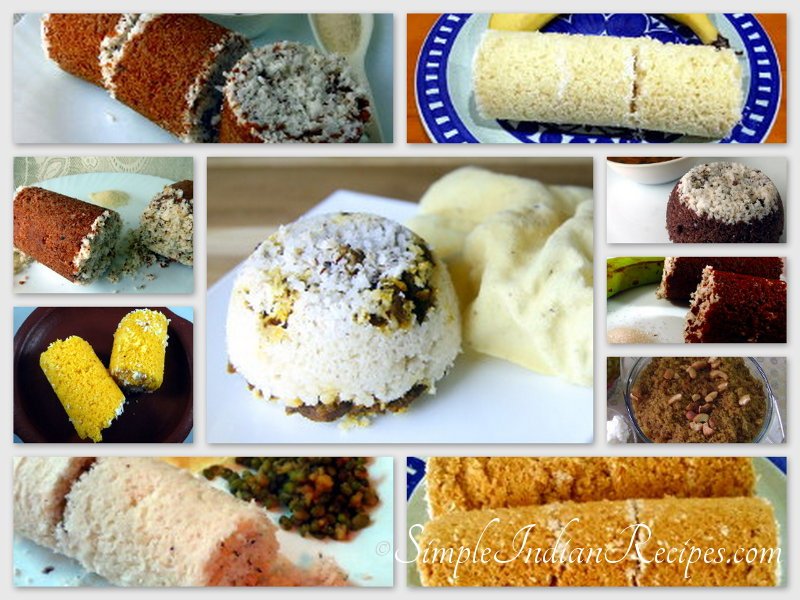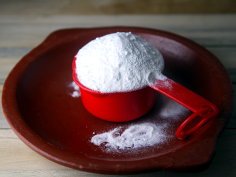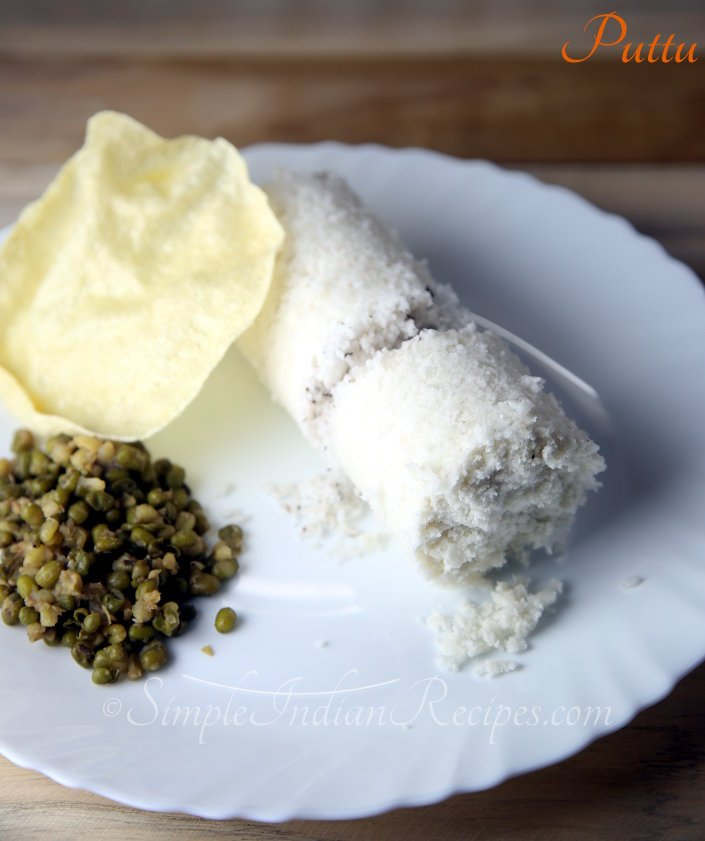- Submitted by Dahlia
(Steamed Puttu, Pittu)

Puttu is a steamed cake commonly made by layering moistened flour (mostly rice flour) and grated coconut. How did this humble dish become so popular? Is it because it is so simple to make? In my hometown, Kanyakumari district, our ancestors used to make puttu almost every day for breakfast. Our parents have a feeling of satisfaction even now only when they eat hot steamed puttu with a glass of hot tea. Being steamed, it is healthy breakfast option with no fat added. Puttu goes well with many vegetarian and non-vegetarian curries. Most of the people just like to enjoy it with some sugar and banana.
Origin of Puttu
Puttu is a traditional South Indian breakfast dish, specially popular in Kerala. In Sri Lanka it is known as pittu. Even though it is popular in Kerala today, It was present in Tamilnadu since ancient days, as we can see it mentioned in Tamil literatures. Pittu is known to the ancient Tamils of the 'Sangam' period as is evident from the 'Pittukku Mann Sumantha Kathai'. The legend goes as follows:-
Due to incessent rains in the catchment area, the river Vaigai was in floods. The Pandiya king decided to strengthen the river banks and divided the work among the citizens. There was a poor lady named Vanthi making her livelihood by selling 'Pittu'. She was also allotted a small portion to be strengthened. Due to her old age she was not able to do her alloted work. As she was an earnest devotee of Lord Shiva, she approached him. Lord Shiva appeared to her as a labourer. The old lady was not able to offer any wages for the work. Shiva accepted to work for the lady in return for some Pittu crumbs as wages and went to the riverside. Due to the food coma instigated by the Pittu crumbs, Lord Shive dozed off in the river bank without working. The pandiya king who came supervising the work was shocked and asked his attendents to wake him and make him work. Lord Shiva did not comply immediately. The King decided to lash him with a cane for being a work shirker. However, the lash he gave to Lord Shiva was felt by the whole world, including the King himself. It was then that the King realized that the person was not any ordinary man but Lord Shiva himself who had come down to help the helpless persons who were dependent on him. This thiruvilayadal (Divine Game of Lord Shiva) happened in the month Avani and in the Moolam star. The same is remembered every year during the Avani Tiruvizha (festival) in Meenakshi Sundareshwar Temple at Madurai.
Puttu Maker
To make Puttu, you need a puttu maker. This usuall has a small base pot called kudam for boiling water and a puttu kutty that is filled with flour and placed on top. There are available in stainless steel, aluminium, bamboo, brass etc. These days, cheratta puttu makers are available, which is shaped like a coconut shell. Also, puttu kutty to be placed on top of a pressure cooker is also available. Please do buy the one which appeals to you the most. I have shared the links of a few models available online. Those interested can purchase it.
(As an Amazon Associate I earn from qualifying purchases.)
Puttu Flour

What makes puttu so simple to prepare is that it needs no prior planning unlike other South Indian tiffin items. The flour can be prepared as a big batch and stored for many months. If the flour is ready, making puttu takes less than 15 minutes. It is a great option for unexpected guests. Not only is puttu flour used for making puttu but it can also be used to make many other South Indian tiffin varieties.
Puttu flour is basically made by washing, soaking the raw rice for some time, air drying it, powdering and then roasting it. Once this is ready it can be used to make puttu immediately or stored for 6-8 months. I have given in detail the steps to make puttu flour at home here. The most common form of puttu is the rice flour puttu. Any puttu flour like ragi flour, red rice flour, bamboo rice flour, black rice flour etc. can be prepared in the exact same way.
Make puttu flour at home ⟩⟩
Types of Puttu
As I have mentioned above, these soft, steamed cakes can be made using many different grains. Just like we have varieties of pulao, biryani, idli and dosa, we can prepare interesting variations to the traditional puttu. More flavours can be added, meat or veggies can be included to improve its nutritious value and multiple layers can be included. Here is a list of puttu varieties for you try each day. You no longer have to prepare the same puttu every day, make a new interesting one each day.
1. Rice Flour Puttu
This is one of the basic and most common variety of puttu made in Kerala. It is made with roasted raw rice flour that is either made at home or store bought.Rice flour puttu is very soft and easy to digest.
Go to rice flour puttu recipe ⟩⟩
2. Red Rice Puttu
Red rice is commonly used for cooking and making puttu flour in Kerala. Tamilnadu has a different variety of red rice which is specially used for making puttu. Red rice has most of the nutrition retained which makes it a healthy choice.
Go to red rice puttu recipe ⟩⟩
3. Black Rice (Kavuni Arisi) Puttu
Kavuni arisi or black rice is a speciality of the chettinadu region of Tamil Nadu. It is packed with nutrition and anti-oxidants that gives it the deep purple colour. Many dishes are made with this rice and puttu is one of them.
Go to black rice puttu recipe ⟩⟩
4. Bamboo Rice (Moongil Arisi) Puttu
Moongil Arisi or Bamboo rice is the seeds of the Bamboo shoot that comes when the plant is about to die. This makes it a rare thing. These days Bamboo rice is found in super markets though it is on the pricier side. This also has amazing health benefits, so try including Bamboo rice in the form of puttu in your diet.
Go to bamboo rice puttu recipe ⟩⟩
5. Corn Puttu
Corn semolina or broken corn is available in all supermarkets in India. This is especially good for making upma and puttu. The puttu made with this has a pretty looking yellow colour with a nutty aroma.
Go to corn puttu recipe ⟩⟩
6. Ragi Puttu
Ragi or Finger Millet is one of the healthiest grain that is native of our country India. It has been used as a main food item from ancient days. Ragi has a earthy flavour which is the reason many people do not like it. With a good side, you can still enjoy this puttu and get benefitted by all its health benefits.
Go to ragi puttu recipe ⟩⟩
7. Wheat Puttu
Wheat is mainly used by North Indians for all types of rotis. It can also be used for making puttu. This makes it easier for South Indians to get wheat in their diet.
Go to wheat puttu recipe ⟩⟩
8. Rava Puttu
Rava has a nice taste and texture. It is used for making kesari (sheera) and upma. The same rava can also be used to make another variety of puttu which comes out very tasty.
Go to rava puttu recipe ⟩⟩
9. Aval Puttu
This sweet puttu is prepared with powdered aval (flattened rice) and jaggery. Puttu made with aval has a pleasant aroma and taste. It is popular in Tamil Nadu and specially made during Janmashtami festival.
Go to aval puttu recipe ⟩⟩
10. Malabar Erachi Puttu
For all the non-veg lovers, the people from Malabar region of Kerala have come up with this delicious Erachi Puttu. It is made by layering minced meat (mostly mutton) masala with the puttu. It is indeed a rice and tasty dish.
Go to malabar erachi puttu recipe ⟩⟩
Serving Puttu
- In Kerala, Puttu is served with payaru (boiled green gram) and papadam, Kadala Curry (Black Channa Curry), fish curry, chicken or other non-veg curries, any stew or kurma varieties.
- Puttu is also served with sugar and banana or honey.
